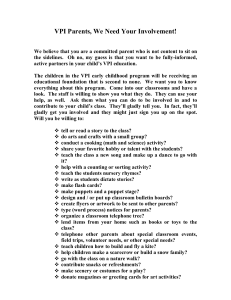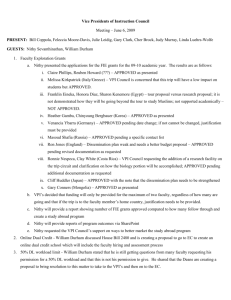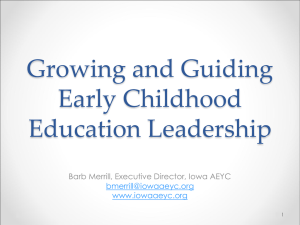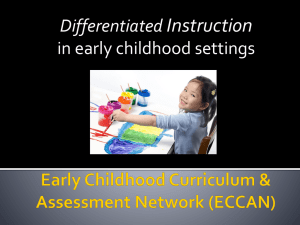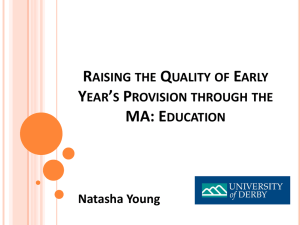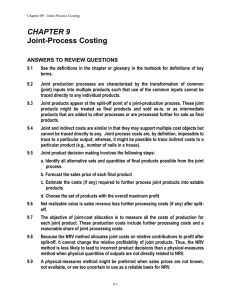2-year Strategic Plan - Smart Beginnings NRV
advertisement
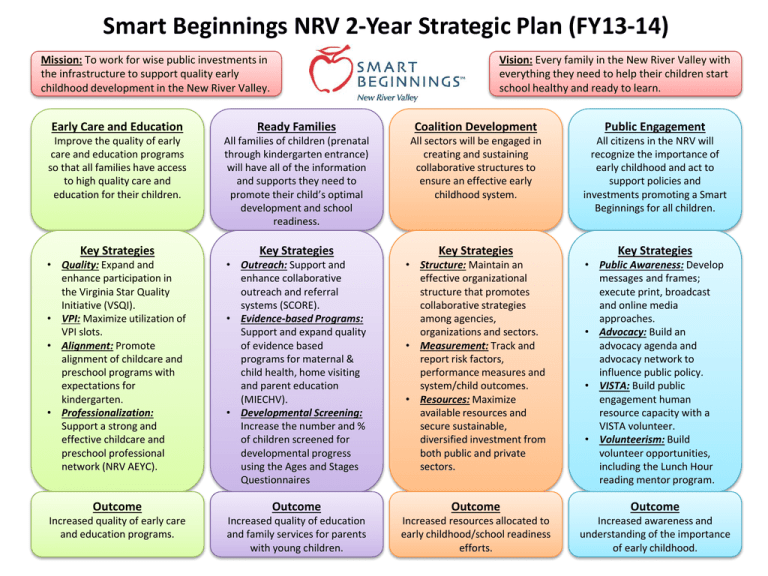
Smart Beginnings NRV 2-Year Strategic Plan (FY13-14) Mission: To work for wise public investments in the infrastructure to support quality early childhood development in the New River Valley. Vision: Every family in the New River Valley with everything they need to help their children start school healthy and ready to learn. Early Care and Education Ready Families Coalition Development Public Engagement Improve the quality of early care and education programs so that all families have access to high quality care and education for their children. All families of children (prenatal through kindergarten entrance) will have all of the information and supports they need to promote their child’s optimal development and school readiness. All sectors will be engaged in creating and sustaining collaborative structures to ensure an effective early childhood system. All citizens in the NRV will recognize the importance of early childhood and act to support policies and investments promoting a Smart Beginnings for all children. Key Strategies Key Strategies Key Strategies Key Strategies • Quality: Expand and enhance participation in the Virginia Star Quality Initiative (VSQI). • VPI: Maximize utilization of VPI slots. • Alignment: Promote alignment of childcare and preschool programs with expectations for kindergarten. • Professionalization: Support a strong and effective childcare and preschool professional network (NRV AEYC). • Outreach: Support and enhance collaborative outreach and referral systems (SCORE). • Evidence-based Programs: Support and expand quality of evidence based programs for maternal & child health, home visiting and parent education (MIECHV). • Developmental Screening: Increase the number and % of children screened for developmental progress using the Ages and Stages Questionnaires • Structure: Maintain an effective organizational structure that promotes collaborative strategies among agencies, organizations and sectors. • Measurement: Track and report risk factors, performance measures and system/child outcomes. • Resources: Maximize available resources and secure sustainable, diversified investment from both public and private sectors. • Public Awareness: Develop messages and frames; execute print, broadcast and online media approaches. • Advocacy: Build an advocacy agenda and advocacy network to influence public policy. • VISTA: Build public engagement human resource capacity with a VISTA volunteer. • Volunteerism: Build volunteer opportunities, including the Lunch Hour reading mentor program. Outcome Outcome Outcome Outcome Increased quality of early care and education programs. Increased quality of education and family services for parents with young children. Increased resources allocated to early childhood/school readiness efforts. Increased awareness and understanding of the importance of early childhood. Early Care and Education GOAL - Improve the quality of early care and education programs so that all families have access to high quality care and education for their children. LONG TERM OUTCOME - Increased quality of early care and education programs Medium Term Outcomes 1. 2. 3. 4. Sustain mentoring and quality improvements at existing VSQI centers. Increase the number of child care centers participating in the VSQI from 11 to 20. Increase the number of children attending 3 and 4 star rated child care centers. Maximize VPI Strategies Actions Measures Quality: Expand and enhance participation in the Virginia Star Quality Initiative (VSQI). • Set annual Star Quality development goals • Evaluate feasibility of initiating Star Quality program for licensed family day home providers • Resource development for sustaining and expanding Star Quality Initiative • Sustain mentoring and quality improvements at existing Star Quality centers • Conduct outreach to centers and raise public awareness about the importance of quality child care • Provide child care providers with orientation to Star Quality and quality improvement systems, including ECERS, ITERS and CLASS instruments • Increase the number of child care providers participating in the Star Quality Initiative VECF Common Outcomes for VSQI # Rated centers by type and # of stars # Mentoring hours # Increasing stars Increase in scores for standards 1-4 # Requesting orientation # Oriented to VSQI # Interested in VSQI # Applied for VSQI # New rated centers # Children served by rated programs VPI: Maximize utilization of VPI slots. • Explore policies and practices ,related funding, access and eligibility for VPI • Identify barriers to access to VPI & develop a plan to address barriers • Convene community leaders in Radford to discuss and plan a strategy to introduce VPI and fully utilize the slots available. • Build the partnership relationship with Radford City Schools through engagement with the VSQI project. $ VPI matching funds secured (Radford) # Available VPI slots utilized Alignment: Promote alignment of childcare and preschool programs with expectations for kindergarten. • Participate in comprehensive kindergarten readiness assessment pilot (when available) TBD Professionalization: Support a strong and effective childcare and preschool professional network (NRV AEYC). • Recruit and train new VSQI raters and mentors and sustain credentials for existing mentors and raters. • Expand content and membership of NRV AEYC Facebook group • Support 2014 VAEYC state conference • Participate in VCPD Western Region coalition # Active mentors # Active raters # New mentors # New raters # NRV AEYC Facebook group members Ready Families GOAL - All families of children (prenatal through kindergarten entrance) will have all of the information and supports they need to promote their child’s optimal development and school readiness. LONG TERM OUTCOME - Increased quality of education and family services for parents with young children. Medium Term Outcomes 1. 2. 3. Better integration among home visiting and child abuse prevention programs Improved outcomes for home visiting participants A more complete, effective and sustainable continuum of care for maternal, infant and child health Strategies Actions Measures Outreach: Support and enhance collaborative outreach and referral systems (SCORE). • Set annual Ready Families development goals • Facilitate planning and coordination of the Behavioral Health-Centralized Intake Pilot project. • Evaluate feasibility of expanding the home visiting collaboration to include parent education, child abuse prevention programs and other maternal and infant health programs • Technical support for collaborative outreach and the SCORE system • Facilitate oversight of SCORE and Centralized Intake Outreach Workers # New referrals # Confirmed Placements % Customer satisfaction scale (SCORE) % Partner satisfaction scale (SCORE) Evidence-based Programs: Support and expand quality of evidence based programs for maternal & child health, home visiting and parent education (MIECHV). • • • • % Customer satisfaction scale (MIECHV) + Targeted MIECHV benchmarks Developmental Screening: Increase the number and % of children screened for developmental progress using the Ages and Stages Questionnaires (including the Social Emotional) • Pilot ASQ Enterprise with 1-3 VSQI participating centers • Pilot ASQ Family Access on the SBNRV website • Develop strategies to better track and report ASQ screenings with home visiting partners • Recruit multiple individuals to receive the CSEFEL and ASQ:3 train-the-trainer training • Further develop relationships with healthcare providers who may use ASQ or other developmental screening tools. Technical Support for MIECHV Quality Improvement Plan (QIP) Engaged participation in the MIECHV QIP Team Expansion of CLASS training Exploration of evidence-based professional development career ladders in early childhood Progress made toward gathering data Progress implementing strategies Coalition Development GOAL - All sectors will be engaged in creating and sustaining collaborative structures to ensure an effective early childhood system. LONG TERM OUTCOME - Increased resources allocated to early childhood/school readiness efforts. Medium Term Outcomes 1. 2. 3. 4. More and deeper engagement from a wider group of individuals A healthy expanding coalition Increased early childhood systems funding Improved Smart Beginnings NRV sustainability Strategies Actions Measures Structure: Maintain an effective organizational structure that promotes collaborative strategies among agencies, organizations and sectors. • • • • • • • Set annual coalition development goals Annual evaluation Complete Smart Beginnings NRV product development initiative Enhance documentation of organizational processes and structures Expansion and diversification of the Leadership Council Update SBNRV Needs Assessment and Strategic Plan Expansion of the regional coalition and committees # LC Members # Businesses on LC # Schools on LC # Active Committees # Partners # Coalition Members Measurement: Track and report risk factors, performance measures and system/child outcomes. • • • • Gather standardized data related to current focus areas Quarterly progress reports Annual report Locality report cards Reports issued Resources: Maximize available resources and secure sustainable, diversified investment from both public and private sectors. • • • • • • Set annual resource development goals Encourage and facilitate volunteerism Facilitate and participate in major collaborative grant applications Develop major donors Develop business sponsorships Develop sources for supporting a coordinator’s salary # Volunteer hours $ Grant dollars raised $ Income earned $ Major donor dollars raised $ Sponsorship dollars raised $ Coordinator salary dollars raised $ Ready Families dollars raised $ Star Quality dollars raised Public Engagement GOAL - All citizens in the NRV will recognize the importance of early childhood and act to support policies and investments promoting a Smart Beginnings for all children. LONG TERM OUTCOME - Increased awareness and understanding of the importance of early childhood. Medium Term Outcomes 1. 2. 3. Increase public awareness and engagement Support policy change Access new resources Strategies Actions Measures Public Awareness: Develop messages and frames; execute print, broadcast and online media approaches. • • • • • • # Small group presentations # Media exposures # Major events # Event attendees # Facebook fans Advocacy: Build an advocacy agenda and advocacy network to influence public policy. • Develop advocacy agenda • Develop advocacy network • Advocate TBD VISTA: Build public engagement human resource capacity with a VISTA volunteer. • Build public engagement human resource capacity with a VISTA • Complete public engagement materials • Evaluate the possibility of adding a second VISTA TBD Volunteerism: Build volunteer opportunities, including the Reading Hour reading mentor program. • Evaluate the Reading Hour pilot program • Plan for a spring 2014 expansion • Grant writing and resource development for an even larger fall 2014 expansion # Centers participating # Reading mentors # Reading friends # Parent and teacher surveys Set annual public engagement goals Information enhancement strategies Small group presentations Public media exposures Major events Social media strategy implementation
